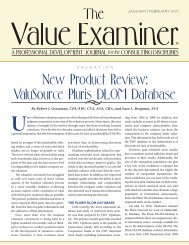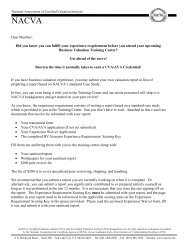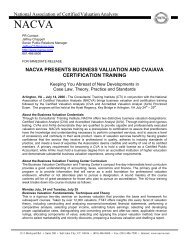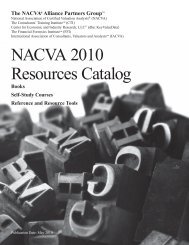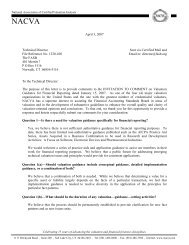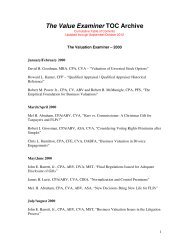VALUATION DISCOUNTS AND PREMIUMS
VALUATION DISCOUNTS AND PREMIUMS
VALUATION DISCOUNTS AND PREMIUMS
Create successful ePaper yourself
Turn your PDF publications into a flip-book with our unique Google optimized e-Paper software.
<strong>VALUATION</strong> <strong>DISCOUNTS</strong> <strong>AND</strong> <strong>PREMIUMS</strong>Fundamentals, Techniques & Theoryk) Columbia Financial Advisors, Inc. Studies (2000)(1) Addressed change in restricted stock discounts resulting from two key events thatincreased the liquidity of these securities over time:(a) In 1990, the SEC adopted Rule 144A, which relaxed the SEC filingrestrictions on private transactions(b) Then in 1997, the holding period requirements under Rule 144 were amendedto permit the resale of limited amounts of restricted stock after one year(additionally, the amendment permits unlimited re-sales of restricted stockheld by non-affiliates of the issuer after a holding period of two years, ratherthan three years)(2) Encompassed the period: January 1, 1996 to April 30, 1997(3) Search of a private placement database provided 123 private placements ofcommon stock during the period covered by the study(4) Transactions with no offer price or public market price available and transactionswith non-U.S. issuers that were not traded in the U.S. were eliminated; as aresult, 23 transactions remained(5) The average discount was approximately 21 percent—discounts ranged from 0.8to 67.5 percent with a median of 14 percent(6) Using the same methodology, another study was conducted:(a) Examined the period: January 1, 1997 to December 31, 1998(b) Identified impact of the increased liquidity of restricted securities as a resultof the reduction of holding period requirements(c) Out of 270 private placements of common stock, 226 were eliminated, asthey did not involve public companies(d) An additional 29 companies were eliminated because no offer processes werereported and/or the placements were not restricted or unregistered(e) Of the remaining 15 transactions the average discount was 13 percent—discounts ranged from 0 to 30 percent with a median of 9 percentl) Management Planning Study (2000)(1) Performed by Robert Oliver and Roy Meyers(2) Covers the 17-year period: January 1, 1980 to December 31, 1996(3) Used 53 transactions without registration rights and 27 transactions withregistration rights(4) The following were the observations regarding the 53 transactions in stockswithout registration rights:(a) The average discount was approximately 27 percent(b) The median discount was approximately 25 percent(c) Only one of the transactions occurred at a price equal to the market price,while the remaining transactions reflected discounts ranging from 3 to 58percent26 – Chapter Seven © 1995–2011 by National Association of Certified Valuators and Analysts (NACVA). All rights reserved.2012.v1 Used by Institute of Business Appraisers with permission of NACVA for limited purpose of collaborative training.



